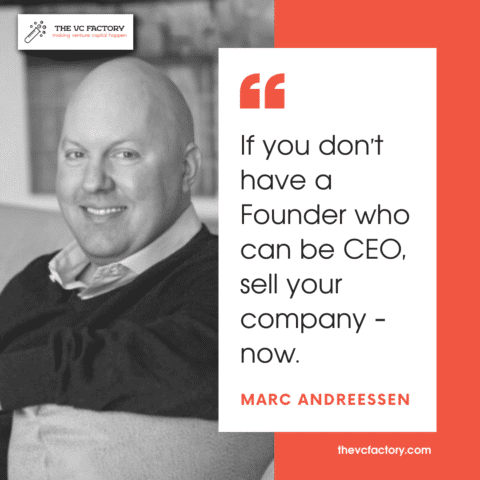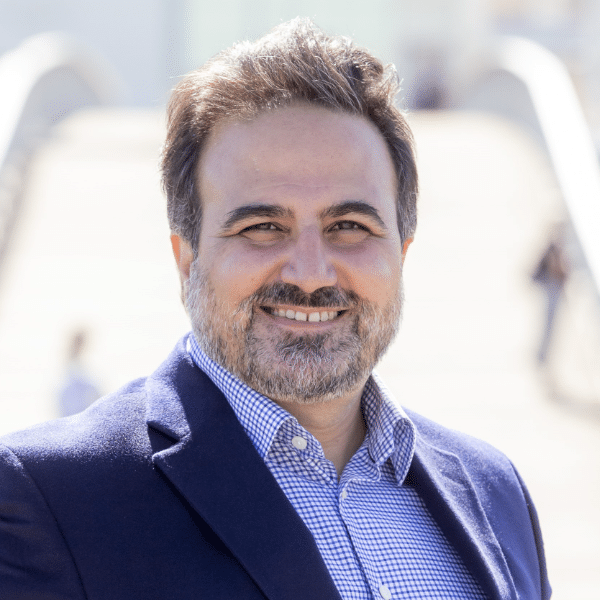“If you don’t have a Founder who can be CEO, sell your company–now.” – Marc Andreessen

Marc Andreessen, often considered one of the smartest VCs in Silicon Valley, is unequivocal on this question. In his “pmarca guide to startups” (Andreessen’s handle on Twitter is @pmarca), he covers a range of startup-related topics such as “Why Not To Do A Startup” to “The Only Thing That Matters”. The last post, Part 9, asks: “How To Hire A Professional CEO”. The answer: “Don’t”. In that case, the only way for Founders is to sell.
In this post, I recap the history of the Founder-CEO movement in startups, ponder the personality traits that successful Founders possess, and draw conclusions on Andreessen’s advice.
The Founder-CEO Is A Recent Reality
Marc Andreessen and Ben Horowitz founded their eponymous VC firm in 2009 with a very distinctive proposition: they would invest only in Founders who had the potential to remain or become CEOs as the company grew.
a16z, as their firm is referred to (there are 16 letters between the first and last letter of Andreessen Horowitz), was one of the first VC outlets to hire in-house professionals tasked with helping Founders succeed. Operating partners mentor portfolio companies across a wide range of topics, including capital raising, go-to-market strategies, marketing, and talent management. The underlying thinking is that Founders partly need to be trained to become CEOs.
In today’s Founder-friendly VC markets, such initiatives have become commonplace. (Yet, entrepreneurs still complain that most VCs don’t add value. I argued elsewhere that this is due to the asset class moving from a maverick mentality to a herd one).
After a product gained a foothold, VCs routinely removed founding CEOs and replaced them with “suits”.
Steve blank (Source: Harvard Business review)
Today, most startup entrepreneurs ignore that staying on board until the exit used to be an exception twenty years ago. In one of the best accounts of this issue, Steve Blank recalls that the famous Founder-CEO stories of the past—Hewlett and Packard, Bill Gates and Paul Allen, Jeff Bezos—remained at the helm because they controlled their companies.
The well-known counter-example is Steve Jobs, infamously fired from Apple to be replaced by an experienced executive. By this point, the Steves owned only 23% of Apple.
When and why did the situation improve for Founder-CEOs?
At least three trends explain the shift, all rooted in the first decade of the 21st century:
- Founders found ways to keep a controlling stake despite dilution from successive funding rounds
- They started cashing out earlier, which made them less reliant on an exit to gain financial security
- Strategic acquisitions became more prevalent as exit routes for startups
I retraced the change in the first two points to a movement spearheaded by Sean Parker. He not only helped a young Mark Zuckerberg secure control of his company (before dual-class shares appeared en masse) but also launched a new mechanism to help Founders cash out before a total sale of their company—the then-called FF shares.
Fluctuating IPO markets and a larger appetite by large companies (many of whom were former startups) explain why M&A activity by strategic buyers took a larger share of the exit market. This had a defining impact on the firing of entrepreneurs. Historically, VC firms tended to take Founders out of C-Suite jobs and replace them with grey-haired executives more apt to reassure financial markets ahead of an IPO.
The emergence of the Founder-CEO needed other factors to take hold: a proven ability to grow into the role and willing financiers.
Winning Personality Traits Meet Willing Venture Capitalists
On top of the external factors mentioned above, a shift in Investors’ minds was necessary for the Founder-CEO trend to take hold. It happened gradually.
The first element was an increasing number of entrepreneurs staying at the helm as their companies became tech giants. Examples abound: Reid Hastings at Netflix, Drew Houston at Dropbox, Ariana Huffington at the Huffington Post, Brian Chesky at AirBnB, Daniel Ek at Spotify, Elizabeth Holmes at Theranos (till 2015), Jack Ma at Alibaba, Marc Benioff at Salesforce, and of course Elon Musk.
I wrote elsewhere about a cognitive bias called representativeness, which is prevalent in Venture Capital and explains how Investors pick the Founders they bet on. Seeing more and more Founders successfully transition to the CEO role helped VCs believe it was possible.
The second factor explaining the change in mentalities is that these entrepreneurs gradually acquired similar skills to great leaders of the past. Initiatives such as Y Combinator and the Lean Startup movement need to be appreciated in that context. Being an entrepreneur is a job and can be learned—at least to a certain extent.
I can be tricked by anyone who looks like Mark Zuckerberg.
Paul Graham (source: The New York Times)
It wasn’t long before pattern-seeking Venture Capitalists started chasing entrepreneurs with CEO potential by focusing on their personality traits. Charisma, boldness in decision-making, the ability to paint a compelling vision, a visceral passion for their mission, an unrelenting drive to find solutions, and resilience often come at the top of the list.
In the webinar What VCs (Should) Look For In Founders, I argue that the cognitive process we use to judge these qualities is fraught with potentially costly mistakes. WeCrashed, the appleTV+ show about Adam Neumann and the WeWork fiasco, offers an entertaining dive into this issue.
Why Sell?
The striking part of Andressen’s phrase is the urge to sell the company if none of the co-Founders is deemed apt to grow into a CEO role. Aren’t alternatives possible? How about applying recipes that worked in the past, such as recruiting an experienced executive to take the company to its next growth level?
Several postulates seem ingrained in Andreessen’s thinking, which may explain his stance. The most decisive one is that no one is better positioned than a startup’s Founder to articulate its mission, influence its culture, and galvanize its employees.
A quick look at the most influential CEOs of 2022 may paint a different picture. The top four spots—Cook at Apple, Nadella at Microsoft, Pichai at Alphabet, and Jassy at Amazon—are occupied by executives who did not create the companies they now lead. (The next three, Musk at Tesla, Zuck at Meta, and Buffett at Berkshire Hathaway, did.)
a16z’s guiding principle is that “professional CEOs are effective at maximizing, but not finding, product cycles” while “founding CEOs are excellent at finding, but not maximizing, product cycles.” In a 2010 post, Ben Horowitz argues that it is easier to train Founder-CEOs to maximize product cycles than the other way round.
Is it necessary for VCs to push for a sale of the company if none of the Founders turns out to be CEO material? It may seem like a radical approach. From Andreessen’s point of view, which is to fund the future HPs and Facebooks, it’s the only approach.
